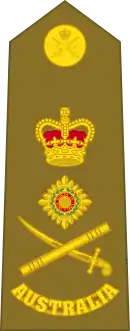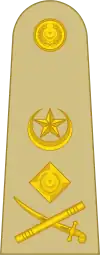A general officer is an officer of high rank in the armies, and in some nations' air forces, space forces, and marines or naval infantry.[lower-alpha 1]
In some usages the term "general officer" refers to a rank above colonel.[1]
The adjective general had been affixed to officer designations since the late medieval period to indicate relative superiority or an extended jurisdiction.
General officer ranks and history
The various grades of general officer are at the top of the military rank structure. Lower-ranking officers in land-centric military forces are typically known as field officers or field-grade officers, and below them are company-grade officers.
Common systems
There are two common systems of general ranks used worldwide.
Variations of one form, the old European system, were once used throughout Europe. It is used in Germany, where it comes from originally, and from where it eventually spread to the United Kingdom and thence subsequently to other Commonwealth countries and the United States.
Old European system
| Marshal, field marshal or general field marshal |
|---|
| Colonel general |
| General (of the infantry / cavalry / artillery etc.) |
| Lieutenant general |
| Sergeant major general, later called major general |
| Brigadier or brigadier general |
In the 17th and 18th centuries, it became customary in Prussia and other German states to confer the rank of "full" general with the addition of the branch of service from which the general emerged and which originally also determined the character of the formations which he commanded, e.g. general of the infantry, general of the cavalry and general of the artillery.
field marshal was used by some countries as the highest rank, while in other countries it was used as a divisional or brigade rank. Many countries (notably pre-revolutionary France and eventually much of Latin America) actually used two brigade command ranks, which is why some countries now use two stars as their brigade general insignia.
As a lieutenant outranks a sergeant major; confusion often arises because a lieutenant is outranked by a major. Originally the serjeant major was, exclusively, the commander of the infantry, junior only to the captain-general and lieutenant general. The distinction of serjeant major general only applied after serjeant majors were introduced as a rank of field officer. Serjeant was eventually dropped from both rank titles, creating the modern rank titles.
The equivalent of the rank of general in the navy was admiral.
French Revolutionary system
| Marshal or Captain general |
|---|
| Army general |
| Army corps general |
| Divisional general |
| Brigade general |
Arab system
The armies of Arab countries use traditional Arabic titles.
| Rank | Transliteration | Translation | Notes |
|---|---|---|---|
| مشير | Mushīr | Counsellor | compare Counsellor of State, State Counsellor etc. compare etymology "mushir" with "shura" |
| فريق أول | Fariq 'awal | First general | equivalent to Commonwealth "full" general |
| فريق | Fariq | General | equivalent to lieutenant general or corps general |
| لواء | liwāʾ | Ensign | (more loosely "flag officer" or "banner") |
| عميد | ʿamīd | Colonel (not to be confused with aqīd, the equivalent rank to a Commonwealth colonel) |
compare etymology with "ʿamood" ("column"); etymologically, translates as "colonel" but equivalent to brigadier/brigade general |
Other variations
Other nomenclatures for general officers include the titles and ranks:
- Adjutant general
- Commandant-general
- Inspector general
- General-in-chief
- General of the Army (which is distinct from the title army general)
- General of the Air Force (USAF only)
- General of the Armies of the United States (of America), a title created for General John J. Pershing, and subsequently granted posthumously to George Washington and Ulysses S. Grant
- Generaladmiral ("general admiral") (German Navy)
- Air general and aviation general
- Wing general and group general
- General-potpukovnik (transl. Lieutenant colonel general, a Serb/Slovenian/Macedonian rank immediately inferior to colonel general, and roughly equivalent to Commonwealth/US major general)
- Director general (a common administrative term sometimes used as an appointment in military services)
- Director general of national defence (most senior rank in the Mexican Armed Forces)
- Controller general (general officer rank in the French National Police)
- Prefect general (the most senior rank of the Argentine Naval Prefecture)
- Master-General of the Ordnance (very senior British military position)
- Police General (most senior rank of the Philippine National Police)
- Commissioner (highest rank of the Bureau of Immigration)
- Jenderal Polisi (Police General), the highest rank in the Indonesian National Police
In addition to militarily educated generals, there are also generals in medicine and engineering. The rank of the most senior chaplain, (chaplain general), is also usually considered to be a general officer rank.
Specific rank of general
In the old European system, a general, without prefix or suffix (and sometimes referred to informally as a "full general"), is usually the most senior type of general, above lieutenant general and directly below field marshal as a four-star rank (NATO OF-9).
Usually it is the most senior peacetime rank, with more senior ranks (for example, field marshal, marshal of the air force, fleet admiral) being used only in wartime or as honorary titles.
In some armies, however, the rank of captain general, general of the army, army general or colonel general occupied or occupies this position. Depending on circumstances and the army in question, these ranks may be considered to be equivalent to a "full" general or to a field marshal five-star rank (NATO OF-10).
The rank of general came about as a "captain-general", the captain of an army in general (i.e., the whole army). The rank of captain-general began appearing around the time of the organisation of professional armies in the 17th century. In most countries "captain-general" contracted to just "general".
General ranks by country
The following articles deal with the rank of general, or its equivalent, as it is or was employed in the militaries of those countries:
- General (Australia)
- General (Bangladesh)
- General (Canada)
- Shangjiang (China) – People's Republic of China (PRC) and Republic of China (ROC/Taiwan)
- General (Denmark), General
- General (Estonia), Kindral
- General (Finland), Kenraali
- General (Germany), General
- Strategos (Greece)
- General (India)
- Daejang (North and South Korea)
- General (Mexico)
- General (Nigeria)
- General (Pakistan)
- General (Poland), Generał
- General (Sri Lanka)
- General (Sweden), General
- General (Switzerland)
- General (United Kingdom)
- General (United States)
- General (Yugoslav People's Army)
Army generals' insignia






 General
General
(Royal Bhutan Army)






 General
General
(Ethiopian Ground Forces)
 General
General
(Armed Forces of Gabon) General
General
(Gambian National Army)
 General
General
(Ghana Army)
_Minister_of_Defence_rank_insignia.svg.png.webp) General
General
(Guyana Army)

.svg.png.webp)
 General
General
(Kenya Army)

 General
General
(Malawian Army)


 General
General
(Namibian Army) General
General
(Nepal Army)
 General
General
(Nigerian Army)





 General
General
(Rwandan Defence Forces)

 General
General
(South African Army)




 General
General
(Ugandan Land Forces).svg.png.webp)

.svg.png.webp)

Air force generals' insignia




 General
General
(Royal Canadian Air Force)







 General
General
(Kenya Air Force)








 General
General
(Rwandan Air Force)

 General
General
(South African Air Force)

 General
General
(Tanzania Air Force Command)
 General
General
(Ugandan Air Force).svg.png.webp)

Naval infantry generals' insignia
Air force and naval equivalents
Some countries (such as the United States) use the general officer ranks for both the army and the air force, as well as their marine corps; other states only use the general officer ranks for the army, while in the air force they use air officers as the equivalent of general officers. They use the air force rank of air chief marshal as the equivalent of the specific army rank of general. This latter group includes the British Royal Air Force and many current and former Commonwealth air forces—e.g. Royal Australian Air Force, Indian Air Force, Royal New Zealand Air Force, Nigerian Air Force, Pakistan Air Force, etc.
In most navies, flag officers are the equivalent of general officers, and the naval rank of admiral is equivalent to the specific army rank of general. A noteworthy historical exception was the Cromwellian naval rank "general at sea". In recent years in the American service there is a tendency to use flag officer and flag rank to refer to generals and admirals of the services collectively.
See also
Notes
- ↑ In the United States, General Officers authorized to display a flag showing their rank are also called "flag officers". Refer: "Flag officer". Merriam-Webster.. In other usages the term "flag officer" usually applies to naval ranks such as admiral, vice-admiral, or rear-admiral.
References
- ↑ "general, adj. and n.". OED Online. March 2021. Oxford University Press. https://www.oed.com/view/Entry/77489?rskey=dCKrg4&result=1 (accessed May 11, 2021)
- ↑ "Ranks". mdn.dz (in French). Ministry of National Defence (Algeria). Retrieved 30 May 2021.
External links
- Generals of World War II
- Schema-root.org: US Generals News feeds for US Generals in the news
- Marines.mil: General Officer Biographies Archived 2008-03-18 at the Wayback Machine Biographies of US Marine Corps General Officers
- Bios & Information on Generals of Western History Information on 10 Generals who influenced Western History



